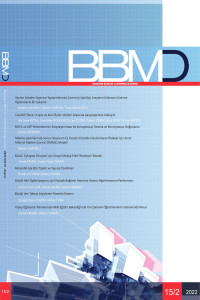Araştırma Makalesi
Derleme
Amaç ve Kapsam
TBV Bilgisayar Bilimleri ve Mühendisliği Dergisi(TBV-BBMD), Bilgisayar Mühendisliği Bölüm Başkanları Kurulu’nun 2004 yılında yapmış olduğu toplantıda alınan karar gereği 2005 yılında yayımlanmaya başlanmıştır. Dergi her yıl iki sayı olarak yayımlanmaktadır.
TBV-BBMD Dergisinin amacı bilgisayar bilimleri ve mühendisliği alanında yapılan özgün araştırma sonuçlarını yayımlamaktır. Dergi makalelerin Türkçe yayımlanmasını teşvik ederek, bilişim alanında Türkçe bilim dilinin geliştirilmesini amaçlar. Türkçe bilmeyen yabancı yazarların makalelerini İngilizce yayımlamayı kabul eder. Türkçe makalelerin başlık ve özlerini İngilizce olarak yayımlar.
Aşağıdaki türlerdeki makaleler dergide yayıma kabul edilmektedir:
· Araştırma makalesi: Özgün bir araştırmayı sonuçlarıyla birlikte sunan makale,
· Derleme makale: Bilgisayar bilimleri ve mühendisliği alanında, belli bir konuda yeterli sayıda bilimsel makaleyi tarayıp, özetleyen, değerlendirme yapan ve bulguları yorumlayan makale,
· Endüstriyel makale: Bilgisayar bilimleri ve mühendisliği alanında,endüstride yapılan araştırma ve geliştirilen yeni ürün veya teknolojilerin açıklandığı makale,
· Tez çalışması: Lisansüstü düzeyde yapılan özgün bir tez çalışmasının genişletilmiş özetini içeren yazı,
· Kitap yorumu: Bilgisayar bilimleri be mühendisliği alanında yayımlanmış yeni bir kitabın tanıtılması ve değerlendirilmesi.
TBV Bilgisayar Bilimleri ve Mühendisliği Dergisinin aşağıda sıralanan konuları kapsamaktadır:
|
Algoritmalar |
Doğal dil işleme |
Sağlık bilgi sistemleri |
|
Atanmış dizgeler |
Hesaplama kuramı |
Şifreleme ve kişisellik |
|
Bilgisayar ağları |
İnsan makine etkileşimi |
İşaret işleme |
|
Bilgi ve bilgisayar güvenliği |
İşletim Sistemi |
Soru ve Yanıtlama Dizgeleri |
|
Bilgi çekme |
Makine öğrenmesi |
Sosyal ağlar |
|
Bilgisayarlı görü |
Nesnelerin İnterneti |
Veri bilimi |
|
Bilgisayar mimarisi |
Oyunlar |
Veri madenciliği |
|
Bulut bilişim |
Örüntü tanıma |
Yapay zeka |
|
Bulanık mantık |
Programlama dilleri |
Yazılım mühendisliği |
|
Büyük veri ve çözümlemesi |
Robotlar ve uygulamaları |
Yüksek başarımlı hesaplama |
Dergimize makale başvurusunda bulunmayı düşünüyorsanız, Dergi Hakkında sayfasındaki dergi yayın politikasını ve Yazar Rehberi'ni incelemenizi öneririz. Yazarlar dergiye gönderi yapmadan önce kayıt olmalıdır. Kaydolduktan sonra, Giriş bağlantısı aracılığıyla 5 basamaklı gönderi işlemine başlayabilir.Okuyucuların yayın bildirimi servisine kayıt olmaları önerilir. Bu işlem dergi giriş sayfasının üst kısmında yer alan Kayıtbağlantısından gerçekleştirilebilir. Bu servise kayıt yaptıran okuyucuya her yeni sayı yayınlandığında İÇİNDEKİLER sayfası e-posta aracılığı ile iletilir. Derginin gizlilik bildiriminde belirtildiği gibi, yazarların kimlik bilgileri ve e-posta adresleri hiç bir şekilde başka amaçlar için kullanılmayacaktır.Araştırma kütüphanelerine, bu dergiyi elektronik dergi kolleksiyonuna almalarını önermekteyiz. Derginin açık kodlu yayın sistemi, kütüphaneyi kullanan akademisyenlerin yayın sürecine katıldıkları diğer dergilerde kullanım için de uygun olabileceğini belirtmek gerekir. Açık Dergi Sitemleri ile ilgili ayrıntılı bilgi Public Knowledge Project sayfasından elde edilebilir.Yazarlar bu dergide yayınlanan çalışmalarını, yayın öncesinde ve sonrasında, kişisel web sitelerinde veya kurumsal arşivlerde, bu dergiye kütüphanecilik kurallarına uygun şekilde referans vererek yayınlayabilirler.Bu dergi; bilimsel araştırmaları halka ücretsiz sunmanın bilginin küresel paylaşımını artıracağı ilkesini benimseyerek, içeriğine anında açık erişim sağlamaktadır.Bu dergi sitesindeki isimler ve eposta adresleri sadece bu derginin belirtilen amaçları doğrultusunda kullanılacaktır; farklı herhangi bir amaç için veya diğer kişilerin kullanımına açılmayacaktır.
Yazım Kuralları
Dergi için Makale Yazım Kuralları Makale Şablonu
Dergiye gönderilecek yazılar MS Word yazım programında aşağıda açıklanan kurallara uygun olarak hazırlanacaktır.
Türkçe bilişim dilini geliştirme ve yaygınlaştırmayı hedef olarak belirlemiş olan dergiye gönderilecek makale yazımında kullanılan Türkçeye özen gösterilmesi özellikle beklenmektedir. Teknik terimler için genel kullanılan terimleri kullanınız. Yeni terim önerileriniz olursa lütfen belirtiniz.
Dergiye gönderilen makaleler, yayın kurulu tarafından gözden geçirilecek ve gerekirse terimler değiştirilebilecektir.
Temel yazım kuralları aşağıda verilmiştir. Ayrıca Yazım kalıbı Word belgesi olarak hazırlanmıştır. Word yazım kalıbında kullanılan biçemler ilgili alanlarda köşeli parantezler içinde yazılmıştır.
Sayfa Özelliği
Kağıt boyutu : A4 Düşey
Üst boşluk : 2 cm
Alt boşluk : 2 cm
Sol boşluk : 1,5 cm
Sağ boşluk : 1,5 cm
Bildiri Ana Başlığı
Türkçe Bildiri Ana Başlığı: Calibri 20 punto, koyu, sayfaya ortalı, ilk satırın üstünde 24 punto boşluk bırakılacak. İki satır olan başlıklarda, satır arası ek boşluk bırakılmayacak. Türkçe başlıktan sonra 6 punto boşluk bırakılacaktır. [Bildiri Ana Başlığı]
İngilizce Bildiri Ana Başlığı: Calibri 20 punto, gri, ortalı ilk satırın üstünde boşluk bırakılmayacaktır. İki satır olan başlıklarda, satır arası ek boşluk bırakılmayacak. İngilizce başlıktan sonra 20 punto boşluk bırakılacaktır. [İngilizce Bildiri Ana Başlığı]
Bildiri Ana Başlığının ilk harfler büyük, diğerleri küçük harf olacaktır.
Yazar bilgileri
Bir satırda en çok 3 yazar bilgisine yer verilecektir. Tek yazarlı makalelerde yazar adı sayfa ortasında, iki yazarlı bildirilerde, yazar adı sütuna ortalı olarak yazılacaktır.
Yazar adları Calibri 10 punto, normal, ortalı yazılacak. [Yazar adı]
Yazar Kurum/Kuruluş adı Calibri 10 punto, yatık, ortalı yazılacak. [Kurum]
Yazar Bölüm adı Calibri 10 punto, yatık, ortalı yazılacak. [Kurum]
Yazar Kent ve Ülke adı Calibri 10 punto, yatık, ortalı yazılacak. [Kurum]
Yazar E-postası Calibri 10 punto, normal, ortalı yazılacak. [Eposta]
Yazar ORCID No Calibri 10 punto, normal, ortalı yazılacak. [ORCID]
Bundan sonraki kısım iki sütun olarak yazılacaktır. Sütun genişlikleri eşit ve aralarındaki boşluk 5 mm olacaktır.
Öz Başlığı [Öz Başlık ]
Calibri 12 punto, kalın, sola yaslı, lacivert renginde, alt boşluk 6 punto olacak [Öz Başlık ]
Öz 10 Calibri 10 punto, yatık, iki yana yaslı olarak yazılacaktır. Türkçe olarak hazırlanacak olan öz bir paragraf olarak hazırlanacak ve en çok 1000 harften oluşacaktır. Öz içinde formül, özel karakter ve semboller kullanılmamalıdır. [Öz]
Anahtar Sözcükler [Anahtar Sözcükler]
Özün altında yer alacak, 10 punto Calibri ve italik olacak. Anahtar Sözcükler koyu ve italik olacak.
Örneğin: Anahtar sözcükler: Veri madenciliği, Veri,
Abstract [Öz Başlık ]
Abstract Calibri 10 punto, yatık, iki yana yaslı olarak yazılacaktır. İngilizce olarak hazırlanacak olan öz bir paragraf olarak hazırlanacak ve en çok 1000 harften oluşacaktır. İngilizce içinde formül, özel karakter ve semboller kullanılmamalıdır. [Öz]
Keywords
Abstract’ın altında yer alacak, 10 punto Calibri ve italik olacak. Keywords koyu ve italik olacak.
Örneğin: Keywords: Data mining, Data [Anahtar Sözcükler]
Başlıklar
Makale içinde üçüncü basamağa kadar başlık kullanılabilir. Bunlara ilişkin bilgiler şöyledir:
Ana Başlık: Calibri 12 punto, kalın, sola yaslı ve asılı, lacivert renginde, alt boşluk 6 punto olacak [Ana Başlık ]
Başlık: Calibri 11 punto, kalın, sola yaslı ve asılı, lacivert renginde, alt boşluk 6 punto olacak [Başlık ]
Alt Başlık: Calibri 10 punto, kalın, sola yaslı ve asılı, lacivert renginde, alt boşluk 6 punto olacak [Alt Başlık ]
Bunların dışında kullanılacak başlıklar Calibri 10 punto, kalın ve italik, sola yaslı ve asılı, siyah renginde, alt boşluk 6 punto olacak. [Eğik Başlık]
Makale Gövdesi
Makale gövdesi iki sütun halinde hazırlanacaktır. Sütün genişlikleri eşit olacaktır. Sütunlar arasındaki boşluk 5 mm olacaktır.
Calibri 10 punto, normal, iki yana yaslı ve siyah renginde, alt boşluk 6 punto olacak [Normal]
Şekil yazısı
Şeklin altında ve ortalı olacak. 9 punto Calibri. “Şekil ve şekil sayısı” yazısı koyu olacak. [Şekil]
Örneğin: Şekil-1: Şekil açıklaması
Çizelge yazısı
Çizelgenin üstünde ve ortalı olacak. 9 punto Calibri koyu. Çizelge yazısı koyu olacak.
Örneğin : Çizelge-1: Çizelge açıklaması
Kaynakça
Kaynak numarası ve kaynak 9 P Times New Roman, önce yazarın soyadı, ardından adının ilk harfi yazılacak. Yayın adı italik olarak yazılacak. Daha sonra yayın yeri ve tarihi yazılacak
Örneğin :
[1] Schaffer, R. L., Mulekar, M. , Mcclave, J. T. Probability and Statistics for Engineers, 2010, pp. 170-172.
Genel Kurallar
Kısaltmalar: Makale içinde yapılacak kısaltmalar, ilk karşılaşıldığı yerde yapılmalıdır. Örneğin Akıllı Taşıt Sistemleri (ATŞ). Toplumun bildiği kısaltmalar doğrudan kullanılabilir. Örneğin İTÜ
Kaynaklar: Metin içinde atıfta bulunulan kaynağın numarası tümcenin sonunda köşeli parantez içinde verilmelidir. Örneğin E. Adalı ve ark. Tarafından yapılan çalışmada ilgili sonuçlara varılmıştır [1]. Makale içinde kaynak numaraları sıralı olmalıdır. Kaynakça makalenin sonunda oluşturulacaktır.
Formüller: Makale içinde yer alan formüller için numara verilmelidir. Formülün numarası, sağ yanda parantez içinde verilmelidir. Örneğin
Y= ax2 + bx + c (1)
Üs ve indisler: Üs ve indisler, matematik formüllerde yazıldığı biçimde yazılmalıdır. Örneğin x2, xi
Birimler: Makale içinde yalnızca SI (MKSA) birim sistemi kullanılmalıdır. Ancak zorunlu durumlarda bu birimlerin dışındaki birimler ikinci birim olarak kullanılabilir. Birimler için kullanılacak olan kısaltmalar uluslararası SI kısaltmaları olmalıdır. Örneğin Kilo: K, Metre: m, Saniye: s, Akım: A (Lütfen saniye için sn kısaltması kullanmayınız)
Alt/Üst Bilgi: Makale içinde alt ve üst bilgi kesinlikle kullanılmayacaktır.
Şekil/Resim: Şekil ve resimler makalede atıf yapıldıktan sonra en yakın alana yerleştirilmelidir. Şekil/Resim numaralı sıralı verilmelidir. Makalede atıf yapılmayan bir şekil veya resim olmamalıdır. Figür değil Şekil yazılmalıdır.
Çizelge: Çizelgeler makalede atıf yapıldıktan sonra en yakın alana yerleştirilmelidir. Makale numaralı sıralı verilmelidir. Makalede atıf yapılmayan bir çizelge olmamalıdır. Tablo değil çizelge yazılmalıdır.
Bilgisayar Bilimleri ve Mühendisliği Dergisinin ana amacı bilişim alanında özenli Türkçeyi geliştirmektir. Bu nedenle Türkçe makalelerde özenli Türkçe kullanılması gerekmektedir. Buna ek olarak Türkçe bildirilerin İngilizce Abstract ve keywords dışında kalan kısımlarında aşağıda açıklanan kurallara uyulması zorunludur.
Sayıların ondalık kısımları virgülle ayrılmalıdır. Örneğin 25,33
Virgül öncesi 0 (sıfır) yazılmalıdır. Örneğin 0,23
Yüzde işareti sayıdan önce yer almalıdır. Örneğin %25
Makalenin Türkçe ve İngilizce kısımlarında yazım yanlışları düzeltilmelidir. Yayın Kurulu, makale içindeki terimleri değiştirebilir. Gerektiğinde tümceyi düzenleyebilir.
Etik İlkeler ve Yayın Politikası
TBV Bilgisayar Bilimleri ve Mühendisliği Dergisi Etik İlkeleri
TBV Bilgisayar Bilimleri ve Mühendisliği Dergisi yayın etiğini en yüksek düzeyde uygulamayı ve yayın etiğinin aşağıdaki ilkelerine uymayı taahhüt eder. Bu bağlamda, yayın etiği kapsamında tüm paydaşların aşağıda belirtilen etik sorumlulukları benimsemesi beklenmektedir. Bu ilkeler Committee on Publication Ethics (COPE), Council of Science Editors (CSE), World Association of Medical Editors (WAME) ve International Committee of Medical Journal Editors (ICMJE) adlı kuruluşların dergi editörleri için geliştirdikleri öneri ve kılavuzlar temel alınarak hazırlanmıştır..
Bu kapsamda TBV Bilgisayar Bilimleri ve Mühendisliği Dergisi COPE Yayın Etiği Komitesi tarafından hazırlanmış olan Yürütme Kılavuza (Code of Conduct) ve Uygulama Rehberi (Principles of Transparency and Best Practice) uygun davranmayı taahhüt eder. Editörler için COPE Rehberi’ne (Cope Guidance for Editors) uyulması editörlerin görevi kapsamında olup, Hakemler için Etik Rehberi (COPE Ethical Guidelines for Peer Reviewers) dergi hakemlerimiz tarafından uyulması zorunludur.
TBV Bilgisayar Bilimleri ve Mühendisliği Dergisinde editör olarak görev alanlar, hakemler ve dergiye makale gönderen yazarlar aşağıda açıklanan etik kurallara uymayı kabul ederler.
Bir Makalede Uyulması Gereken Temel Etik Kurallar
• Uydurma: Araştırma sırasında elde edilmeyen verileri, elde edilmiş gibi göstermedir.
• Çarpıtma: Araştırma sonuçlarını istenen biçime getirmek amacıyla araştırma kayıtlarında, kullanılan aygıtlarda ve işlemlerde değişiklik yapma eylemidir.
• Aşırma: Başkalarının geliştirdiği yöntemleri, verileri, yazıları ve şekilleri geliştirenlerine atıf vermeden kullanma eylemidir.
• Korsanlık: Yayımlanmış bir yayının tümünü veya bir bölümünü kaynak göstermeden veya yazarının onayını almadan kendi yayını gibi yeniden yayımlama eylemidir.
• Çoğaltma: Aynı araştırma sonuçlarını aynı anda birden fazla dergiye yayımlanması amacıyla göndermek ve yayımlatmak eylemidir. Bir çalışma, geliştirme aşamasında birden fazla ortamda ve değişik dillerde sunulabilir. Bu durumda önce yayımlandığı yer belirtilmek ve editöründen izin almak koşulu ile makale olarak yayımlanabilir.
• Dilimleme: Tek bir araştırmanın sonuçlarını bölerek birden fazla yayın hâlinde sunma eylemidir.
• Yazar haklarında yanıltma: Bir araştırmaya katkısı olmayan bir kişinin adını ekleme veya katkısı olan bir araştırmacının adını yazmama ya da yazarların ad sıralarını katkılarına uygun olmayan biçimde yazma eylemleridir.
• Desteği gizleme ve taraflı yayınlar: Ticari kuruluşlar tarafından desteklenen araştırmaları, ticari kuruluşun adını vermeden tarafsız bir yayın gibi sunma eylemidir.
• Taraflı kaynaklar: Bir araştırmaya ilişkin yayının kaynaklar bölümünde, yalnız çalışmayı olumlu yönde destekler nitelikteki çalışmaları göstermek, desteklemez nitelikte olanlara kaynakların içinde yer vermemek dolayısıyla kaynakları taraflı olarak seçmek eylemidir.
Editörlerin Uyması Gereken İlkeler
Dergi editörlerinden, aşağıdaki ilkelere uymaları beklenmektedir.
• Tarafsızlık ve Yayıncıya İlişkin Özgürlük: Editörler gönderilen makaleyi Derginin alan ve kapsamına uygunluk, çalışmanın önemi ve özgünlüğünü dikkate alarak değerlendirirler. Editörler makaleyi hazırlayanlar yazarların ırk, cinsiyet, cinsel yönelim, etnik köken, uyruk veya politik görüşlerini dikkate almazlar. Düzeltme ya da yayınlama kararına Dergi editör kurulu dışında diğer kişi ve kuruluşlar etki edemez. Editörler yayımlanan Dergi sayılarının okuyucuya, araştırmacıya, uygulayıcıya ve bilimsel alana katkıda bulunmasına ve özgün nitelikte olmasına özen gösterir.
• Bağımsızlık: Editörler (Editör ve Yardımcı Editörler) ile yayıncı arasındaki ilişki editör bağımsızlığı ilkesini temel almaktadır. Editörler ve yayıncı arasındaki yazılı anlaşmaya göre, editörlerin tüm kararları yayıncıdan ve dergi sahibinden bağımsızdır. Editörler dergi politikası, yayım kuralları ve seviyesine uymayan eksik ve hatalı makaleleri hiçbir etki altında kalmadan reddederler.
• Gizlilik: Editörler gönderilen bir makaleyle ilgili bilgileri sorumlu yazar, hakemler ve yayın kurulu dışında başka herhangi biriyle paylaşmazlar. En az iki hakem tarafından değerlendirilen makalelerin çift taraflı kör hakemlik sistemine göre değerlendirilmesini sağlar. İki hakem sonuç üzerinde uzlaşamaz ise makale değerlendirilmek üzere üçüncü bir hakeme gönderilir. Hakemlerin kimlikleri gizli tutulur.
• Bilgilendirme ve Görüş Ayrılıkları: Editörler veya yayın kurulu üyeleri, yazarların açık yazılı izni olmaksızın kendi araştırmalarında, Dergiye gönderilen ancak henüz yayımlanmamış olan makaledeki bilgileri kullanamazlar. Editörler kabul ya da reddettiği makalelerle ilgili çıkar çatışması içerisinde olmamalıdır.
• Basım Kararı: Editörler yayımlanmak üzere kabul edilen tüm makalelerin, alanında uzman olan en az iki hakem tarafından değerlendirmesini sağlarlar. Editörler dergiye gönderilen makalelerden hangilerinin yayımlanacağına; söz konusu çalışmaların geçerliliğine, araştırmacılara ve okurlara olan katkı ve önemine, hakemlerin yorumlarına ve yasal koşullara göre karar vermekle sorumludurlar. Editörler makaleleri kabul etmek ya da reddetmek sorumluluk ve yetkisine sahiptir. Dolayısıyla sorumluluk ve yetkisini yerinde ve zamanında kullanmak zorundadırlar.
• Etik Kaygılar: Editörler sunulan bir makaleye veya yayımlanmış makaleye ilişkin etik kaygılar ortaya çıktığında gerekli önlemleri almakla yükümlüdürler. Nitekim fikri mülkiyet haklarından ve etik ilkelerden ödün vermeden iş süreçlerine devam ederler. Editörler etik kaygılar oluşması durumunda COPE Rehberi’ne uygun davranırlar. Etik sorunların önemli olması durumunda düzeltme, geri çekme yoluna gidilir veya konu ile ilgili endişeler dergide yayımlanabilir.
• Dergi Kurullarıyla İşbirliği: Editörler Danışma Kurulu üyelerinin tümünün yayın politikalarına ve yönergelerine uygun olarak süreçleri ilerletmesini sağlar; Danışma Kurulu üyelerine yayın politikaları hakkında bilgi verir. Danışma Kurulu üyelerinin çalışmalarını bağımsız olarak gerçekleştirmelerini sağlar. Yeni Danışma Kurulu üyelerinin katılmasını sağlar. Değerlendirme için Danışma kurulu üyelerinin uzmanlığına uygun çalışmaları göndermelidir. Danışma Kurulu ile düzenli olarak etkileşime geçer
Yazarların Uyması Gereken İlkeler
Yazarlardan, aşağıdaki ilkelere uymaları beklenmektedir.
• Makale Kapsamı: Özgün araştırmanın yazarları, yapılan çalışmanın ve sonuçların doğru bir şekilde sunulmasını ve ardından çalışmanın öneminin tarafsız bir şekilde tartışılmasını sağlamalıdır. Makale yeterli ayrıntı ve kaynakları içermelidir.
• Veri Erişimi ve Saklanması: Yazarların çalışmalarının ham verilerini saklamaları gerekmektedir. Gerektiğinde, dergi tarafından istenmesi durumunda editör incelemesi için sunabilmelidirler.
• Özgünlük ve Aşırma: Yazarlar tamamen özgün eserleri göndermelidirler ve başkalarının çalışmalarını veya sözlerini kullanmışlarsa, bu uygun şekilde alıntılanmış olmalıdır. Aşırma tüm biçimlerinde etik olmayan yayıncılık davranışını oluşturur ve kabul edilemez. Bu nedenle dergiye makale gönderen tüm yazarlardan benzerlik oranı raporu istenmektedir.
• Birden çok, Yinelenen, Yedekli veya Eşzamanlı Gönderim / Yayın: Yazarlar başka bir dergide daha önce yayınlanmış bir makaleyi değerlendirilmek için göndermemelidir. Bir makalenin birden fazla dergiye aynı zamanda sunulması etik olmayan yayıncılık davranışıdır ve kabul edilemez.
• Makalenin Yazarlığı: Yalnızca çalışmaya katkısı olan kişilerin adları yazar olarak yazılmalıdır. Yazarlık ölçütleri şu şekildedir; (i) tasarım, uygulama, veri toplama veya çözümleme aşamalarına katkı sağlamıştır (ii) yazıyı hazırlamış veya önemli bilgi katkısı sağlamış veya eleştirel olarak değerlendirmiş veya (iii) makalenin son halini görmüş, onaylamış ve yayımlanmak üzere teslim edilmesini kabul etmiştir. Sorumlu yazar tüm yazarların (yukarıdaki tanıma göre) yazar listesine katılmasını sağlamalı ve yazarların makalenin son halini gördüklerini ve yayınlanmak üzere sunulmasını kabul ettiklerini beyan etmelidir. Derginin editör kurulu üyelerinin yazarı olduğu makaleler olabildiğince en az sayıda kabul edilir. Bu durumda mutlaka kör hakemlik kuralları işletilir.
• Beyan ve Çıkar Çatışmaları: Yazarlar mümkün olan en erken aşamada (genellikle makale gönderimi sırasında bir bildirme formu sunarak ve makaleye bu açıklamayı dâhil ederek) çıkar çatışmalarını belirtmelidirler. Çalışma için tüm mali destek kaynakları beyan edilmelidir (varsa hibe/fon numarası veya diğer referans numarası dâhil).
• Hakem Değerlendirme Sürecine Katılma: Yazarlar hakem değerlendirme sürecine katılmakla yükümlüdürler ve editörlerin ham veri isteklerine, açıklamalara ve etik onayının kanıtlarına ve telif hakkı izinlerine derhal yanıt vererek tam olarak iş birliği yapmakla yükümlüdürler.
• Yayımlanan Eserlerde Temel Hatalar: Yazarlar yayımlanan çalışmalarında önemli yanlışlıklar gördüklerinde, dergi editörlerini veya yayıncılarını derhal bilgilendirmek zorundadırlar. Ayrıca makaleyi yayımdan çıkarmak veya bir düzeltme yazısını (erratum) göndermek için dergi editörleriyle veya yayıncılarıyla işbirliği yapmakla yükümlüdür. Editörler veya yayıncı, yayımlanan bir çalışmanın önemli bir yanlışlık içerdiğini başkalarından öğrenirse, yazarın makaleyi derhal düzeltmesini veya makale içeriğindekilerin doğruluğuna ilişkin kanıt sunmasını ister. Bunlar yerine getirilmez ise makalenin kaldırılması yönünde davranır.
Hakemlerin Uyması Gereken İlkeler
Hakemlerden, aşağıdaki ilkelere uymaları beklenmektedir.
• Hakemler değerlendirmeyi verilen süre içinde tamamlayabilecekse, bu sorumluluğu almalıdır. Kasıtlı bir gecikmeye neden olmamalıdır. Ek süre gerekiyorsa, bunu Dergiye derhal bildirmelidir.
• Gizlilik kurallarına sadık kalınmalıdır. Değerlendirme sırasında ve sonrasında Dergide yayımlananın dışında, hakemlikle ilgili bilgiler açıklanmamalıdır.
• Değerlendirme sırasında elde edilen bilgi, hakemin veya herhangi bir organizasyonun çıkarları için ya da başkalarının aleyhine kullanılmamalıdır.
• Tüm potansiyel çıkar çatışmaları (kişisel, finansal, profesyonel, siyasi veya dini) dergiye önceden bildirilmelidir. Bu durum hakemlik talebinin kabulünden sonra ortaya çıksa bile, dergi ile mutlaka görüşülmelidir.
• Değerlendirme, işin gereğine uygun olarak yapılmalı ve kişisel ve profesyonel önyargılardan uzak durulmalıdır.
• Değerlendirmelerde nesnel ve yapıcı olunmalıdır. Yazara, makalesini iyileştirebilmesi için geri bildirim sağlanmalıdır.
• Derginin izni olmadan, yazarlarla doğrudan iletişime geçilmemelidir.
• Makale derginin talimatları, politikaları vs. dikkate alınarak okunmalı ve değerlendirilmelidir. Açık olmayan ya da eksik bir bilgi varsa, dergi ile iletişime geçilmelidir.
• Değerlendirme sürecinin herhangi bir aşamasında çalışma ile ilgili etik olmayan bir durumla karşılaşılırsa veya araştırma ile ilgili bir suiistimalden şüphelenilirse, dergi bu durumdan haberdar edilmelidir.
Hakemler aşağıda belirtilen durumlarda değerlendirmeyi reddetmelidir.
• Hazırlık aşamasında olan veya başka bir dergide yayınlanması söz konusu olan bir çalışmaya çok benzer bir başka eserin değerlendirilmesi istenirse.
• Derginin hakemlik biçimi ile ilgili sorunlar varsa (örneğin, açık değerlendirme söz konusu ise ve hakemlerin kimlikleri yazarlara açıklanıyorsa).
Hakemleri, değerlendirme formunu hazırlanırken aşağıdaki hususlara dikkat etmelidirler.
• Geri bildirim konusunda derginin yönergelerine uyulmalıdır.
• Editörlerin sonuç kararlarını verirlerken adil olabilmelerini sağlamak amacıyla hakemler eleştirilerde çok net olunmalı ve uygun gerekçeler sunulmalıdırlar.
• Çalışmanın yazarın emeği olduğu unutulmamalı ve makale hakemin tercih ettiği biçimde baştan yazılmamalıdır.
• Türkçe konusunda duyarlı olunmalıdır.
• Geri bildirim titizlikle yapılmalıdır.
• Çalışmada adı geçen başka yazarlarla ilgili olumsuz yorumlarda bulunulmamalıdır.
• Editör için yapılan yorum ve tavsiyeler tutarlı olmalıdır.
• Yazarın görmeyeceği düşünülerek iftira ve suçlamalar içeren yorumlar yazılmamalıdır.
TBV Bilgisayar Bilimleri ve Mühendisliği Dergisi Yayın Politikası
Türkiye’de Bilgisayar Mühendisliği, Yazılım Mühendisliği, Bilgisayar Bilimleri ve Bilişim Sistemleri adıyla kurulmuş yaklaşık 180 bölüm bulunmaktadır. Bu bölümlerin başkanları, “Bilgisayar Mühendisliği Bölüm Başkanları” (BMBB) Kurulu adıyla 1995 yılından başlayarak her yıl en az bir kez toplanmaktadırlar. BMBB Kurulu 2004 yılında aldığı bir kararla “TBV Bilgisayar Bilimleri ve Mühendisliği” adında hakemli bir bilimsel dergi 2005 yılında yayımlanmaya başlatmıştır.
İlgili toplantıda derginin amaçları şöyle belirlenmiştir:
• Bilgisayar bilimleri ve mühendisliği alanında yapılan özgün araştırma sonuçlarını yayımlamaktır.
• Dergi makalelerin Türkçe yayımlanmasını teşvik ederek, bilişim alanında Türkçe bilim dilinin geliştirilmesini amaçlar.
• Türkçe bilmeyen yabancı yazarların makalelerini İngilizce yayımlamayı kabul eder.
• Türkçe makalelerin başlık ve özlerini İngilizce olarak yayımlar.
Makale Türleri
Dergiye aşağıdaki türlerdeki makaleler kabul edilmektedir:
• Araştırma makalesi: Özgün bir araştırmayı sonuçlarıyla birlikte sunan makale,
• Derleme makale: Bilgisayar bilimleri ve mühendisliği alanında, belli bir konuda yeterli sayıda bilimsel makaleyi tarayıp, özetleyen, değerlendirme yapan ve bulguları yorumlayan makale,
• Endüstriyel makale: Bilgisayar bilimleri ve mühendisliği alanında, endüstride yapılan araştırma ve geliştirilen yeni ürün veya teknolojilerin açıklandığı makale,
• Tez çalışması: Lisansüstü düzeyde yapılan özgün bir tez çalışmasının genişletilmiş özetini içeren yazı,
• Kitap yorumu: Bilgisayar bilimleri be mühendisliği alanında yayımlanmış yeni bir kitabın tanıtılması ve değerlendirilmesi.
Dergiye gönderilebilecek makaleler aşağıda belirtilen alanlarda olabilir. Zaman içinde yeni araştırma konuları eklenebilir.
Algoritmalar Doğal dil işleme Sağlık bilgi sistemleri
Atanmış dizgeler Hesaplama kuramı Şifreleme ve kişisellik
Bilgisayar ağları İnsan makine etkileşimi Sinyal işleme
Bilgi ve bilgisayar güvenliği İşletim Sistemi Soru ve Yanıtlama Dizgeleri
Bilgi çekme Makine öğrenmesi Sosyal ağlar
Bilgisayarlı görü Nesnelerin İnterneti Veri bilimi
Bilgisayar mimarisi Oyunlar Veri madenciliği
Bulut bilişim Örüntü tanıma Yapay zeka
Bulanık mantık Programlama dilleri Yazılım mühendisliği
Büyük veri ve çözümlemesi Robotlar ve uygulamaları Yüksek başarımlı hesaplama
Makale Kabul Süreci
Dergiye gönderilen makalelerin kabul süreci şu aşamalardan oluşmaktadır:
1. Gönderilen her makale ilk aşamada en az iki hakeme gönderilmektedir.
2. Hakem ataması, dergi editörleri tarafından yapılmaktadır. Derginin hakem havuzunda yaklaşık 200 hakem bulunmaktadır ve bu hakemler ilgi alanlarına göre sınıflandırılmıştır. Her hakeme ilgilendiği konuda makale gönderilmektedir. Hakem seçimi çıkar çatışmasına neden olmayacak biçimde yapılmaktadır.
3. Hakemlere gönderilen makalelerde yazar adları kapatılmaktadır.
4. Hakemlere bir makalenin nasıl değerlendirileceği açıklanmaktadır. Makale, özgünlük, bilimsel önemi, kaynaklarının kalitesi ve yeterliliği, yazım kalitesi, konunun güncelliği ve dergiye uygunluğu açısından değerlendirmeleri istenir.
5. İki hakemin olumlu görüş bildirdiği makaleler editörler tarafından benzerlik incelemesinden geçirilir. Makalelerdeki benzerliğin %25’ten küçük olması beklenir. İki hakemin görüşü uyuşmuyor ise makale bir başka hakeme daha gönderilir
6. Tüm aşamaları geçmiş olan bir bildiri dil ve sunuş açısından editör tarafından incelenir ve gerekli düzeltme ve iyileştirmeler yapılır. Gerekirse yazarlara durum bildirilir.
Özenli Türkçe Kullanımı
TBV Bilgisayar Bilimleri ve Mühendisliği Dergisi’nin temel amaçlarından birisi, bilişim alanında Türkçe yayınlara olanak sağlamak ve bilişim alanında Türkçe deyim ve terimleri kazandırmaktır. Bu nedenle Hakemler tarafından kabul edilen ancak özenli Türkçe kullanılmayan ve editör tarafından düzeltilmesi olanaksız görülen makaleler dergide yayımlanmaz. Hakemlerin kabul ettiği bildirilerin Türkçe açısından incelenmesi ve değerlendirilmesi Türkçe Dil Editörü tarafından yapılmaktadır.
Makale Kalıbı
Bir makalenin hazırlanmasına ilişkin yazım kalıbı (formatı) ayrıntılı biçimde yazarlara duyurulmaktadır. Ayrıca yazarlara kolaylık olması için bu kalıp kendilerine sunulmaktadır. Dergiye gönderilen makalelerin Dergi yazım kalıbına uygun olup olmadığı incelenmektedir. Editör tarafından düzeltilebilecek uyumsuzluklar, editör tarafından düzeltilmektedir, düzeltilemeyen bildirilerin düzeltilmesi yazarlardan istenmektedir.
Yayın Sıklığı
Dergi Haziran ve Aralık aylarında olmak üzere yılda iki sayı, bir sayı olarak yayımlanır. Derginin ilk 7 sayısı basılı olarak ve Derginin web sayfasında yayımlanmıştır. Daha sonraki sayılar DergiPark’ta yayımlanmaktadır.
Ücret Politikası
TBV Bilgisayar Bilimleri ve Mühendisliği dergisine makale gönderim/süreç işletimi ücretsizdir.
Dergi Kurulları
Baş Editör

Dil Editörü
Editör Kurulu




https://i.creativecommons.org/l/by-nc/4.0Makale Kabulü | |
Çevrimiçi makale yüklemesi yapmak için kullanıcı kayıt/girişini kullanınız. Dergiye gönderilen makalelerin kabul süreci şu aşamalardan oluşmaktadır: 1. Gönderilen her makale ilk aşamada en az iki hakeme gönderilmektedir. 2. Hakem ataması, dergi editörleri tarafından yapılmaktadır. Derginin hakem havuzunda yaklaşık 200 hakem bulunmaktadır ve bu hakemler ilgi alanlarına göre sınıflandırılmıştır. Her hakeme ilgilendiği konuda makale gönderilmektedir. Hakem seçimi menfaat çatışmasına neden olmayacak biçimde yapılmaktadır. 3. Hakemlere gönderilen makalelerde yazar adları kapatılmaktadır. 4. Hakemlere bir makalenin nasıl değerlendirileceği açıklanmaktadır ve aşağıda görülen değerlendirme formunu doldurmaları istenmektedir. 5. İki hakemin olumlu görüş bildirdiği makaleler editörler tarafından benzerlik incelemesinden geçirilir. Makalelerdeki benzerliğin %25’ten küçük olması beklenir. 6. Tüm aşamaları geçmiş olan bir bildiri dil ve sunuş açısından editör tarafından incelenir ve gerekli düzeltme ve iyileştirmeler yapılır. Gerekirse yazarlara durum bildirilir.
|


